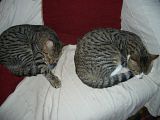-
Posts
1,281 -
Joined
-
Last visited
Content Type
Profiles
News and Information
Tutorials
Product Reviews
Supplier Listings
Articles
Guitar Of The Month
Links and Resources
Forums
Gallery
Downloads
Posts posted by Ben
-
-
I like it a lot! You recessed the diamond plate right? It looks great
-
-
I second Geo's advice. Melvyn Hiscock's book is great, and drawing everything out accurately and full size is very sensible.
-
I like it!
Its got a great original look
-
This is a pretty good site for some basics:
Cool, thanks for the link!
I know very little music theory, and have only learnt a couple of scales 'by sight', (actually my method has been to draw dots in tippex on one of my old guitars on every fret thats 'allowed', then solo away on just the allowed frets a lot, until it stuck in my memory and I could do it on a guitar without the dots
 )
)... but after reading that site a little and seeing the scales put simply as gaps between notes in half steps (e.g. 'Major: 2-2-1-2-2-2-1' etc), I found that if I can remember the sequence of gaps, I can work out where to put my fingers as I play, which I seem to find a lot easier than remembering a picture of a fretboard.
It just never clicked in my mind that I could remember a scale just by remembering the sizes of the 'gaps' like that. I presumed that to remember a scale any other way than visually would mean that I'd have to first learn off by heart which frets were A's , Bb's B's and so on (which I've never bothered to do. I can work them out quite easily, but I have to pause to think, which of course I dont have time for when playing [and this method is only working for me currently because I'm only playing in the key of E, since the E's are the only notes that I know all the positions of on the fretboard from memory]).
Basically I'm just feeling stupid for not thinking about this and realising this sooner

Could have saved myself a lot of time!
-
I'd love it if these self tuning devices ever came down to a price where they were easily affordable.
You know... I cant imagine that they're actually *that* complex in principle... It definitely wouldn't be easy, but I wonder if anyone could make a DIY version? You could steal some of the circuitry from an electronic tuner to make the job a lot simpler.
Hmmmm....
-
pfft +1
This is not quite the same thing as intonation....it has to do with the imperfections of the 12-tone scale, and the fact that in an equal-tempered 12-tone scale the frequencies of the 3rds (and 7ths I think...) are not an interger fractional harmonic of the root (if I'm recalling this correctly).
In an equal tempered 12-tone scale, you get from a lower note to the next-higher note (a half-step up) by taking the root frequency and multiplying it by 2^1/12...to get the frequency of a note 3 half-steps away, you'd multiply the root freq by 2^3/12...a note 6 half-steps away, 2^6/12...and so on.
But the harmonics of the root are found by taking the root frequency and multiplying it by a factor (1+N/12) where N is the scale interval (2nd, 3rd, 4th, etc). When you play these notes together with the root, certain wavelengths (notes) will have (be) harmonics in phase with the root (4ths, 5ths, and octaves where the fraction N/12 reduces to 1/Y...like 4/12=1/3 and 6/12=1/2), while the others will not be in phase with the root (2nds, 3rds, 6ths, 7ths, minors).
This is why, when you play a (let's say) Dno3, it sounds smooth....but when you play Dmaj and add the 3rd, you hear this off-freq "beating" because the 3rd is not a natural harmonic of the root.
Example:
C4 is 261.63 Hz (middle C)
F4 is 349.23 Hz (5 half-steps up from C4, and an interval of a fourth above C4)
so 349.23/261.63 = 2^5/12 (ok)
but also 349.23/261.63 = 1 and 4/12ths (or 1-1/3) so F4 is a 4/12ths (+1) harmonic of C4
Wavelengths are IN-PHASE!! (same for the 5th which is 1-1/2 harmonic of C4)
now...
C4 is 261.63 Hz (middle C)
E4 is 329.63 Hz (4 half-steps up from C4, and an interval of a major-third above C4)
so 329.63/261.63 = 2^4/12 (ok)
but also 329.63/261.63 = 1.26 which is 1 and 3.11/12ths (i.e. the fraction does not have an integer in the numerator, i.e. it is a little sharper than the natural 1-1/4 harmonic)
Wavelengths are NOT in-phase!! This makes the 3rd sound out of tune to the ear, even though it is in fact perfectly intonated.
But you could bring this major-3rd in phase by detuning it slightly (by 0.11/12ths exactly...)...that's why the fretboard has all those humps underneath the G-string...to drop the major 3rd of all your 6-string barre chords into phase with the root.
The problem of course is that you can play 3rds (and 2nds and 7ths) all over the fretboard, not just where you play those "campfire chords". So any one fret arrangement works only for certain keys, tunings and chords....not all over the neck...if you commonly play different chord inversions, this scheme will work for only one set of them. And it is also the reason the company offers several different "temperaments" to their fret shapes.

Very interesting.... where did you learn/ read all this?
-
-
Charles Manson (the guy who makes Matt Bellamy's guitars)
 So thats where his killer tone comes from! [/obligatory bad joke]
So thats where his killer tone comes from! [/obligatory bad joke]I think its Hugh Manson... Charles Manson was famous for something slightly different


-
What is a paisley by the way? I know the pattern, but does the word mean anything, or the shape???
http://en.wikipedia.org/wiki/Paisley_%28design%29
"The pattern was adapted in India to its familiar shape and spread to Scotland when soldiers returning from the colonies brought home cashmere woolshawls. From roughly 1800 to 1850 , using Jacquard looms, the weavers of the town of Paisley, Renfrewshire, Scotland, adapted the design to weave woollen shawls, hence the design became known as the Paisley pattern."
"Although the influence is not clear, the Turkish tughra calligraphic seal strongly resembles the paisley shape. Some design scholars call the distinct shape boteh and believe it is the convergence of a stylized floral spray and a cypress tree: a Zoroastrian symbol of life and eternity. It has been suggested that paisley is also a representation of fractals. However, given the time frame of its origin (16th century) the paisley design resembles and is consistent with the shape of the Indian and/or European medicinal leech. The paisley design often incorporates pregnant leeches; and a body cavity containing baby leeches"
-
-
Out of curiosity, what were you testing?
-
Nice wood!
Although after my last project, That block of zebrano looks more ominous than it would have previously

It was worth it in the end, but (as you probably know) its a bitch to plane and route. If you dont pay careful attention to the grain direction you can get some crazy tearout.
-
Are you talking about the string angle from the tuner to the nut? With the Beast headstock, as wide as it is, I really couldn't get the tuners any closer to the center.
Yeah, I would have redesigned the headstock slightly and slimmed it just a little (mostly so towards the end of it), so that it was almost the same, but just a little thinner, allowing you to get a slightly straighter string pull... but if what you have workss fine then its no big deal.
The bird wings are the same wood as the top of the bass (sycamore) with the same dye. However, they show up a little brighter since they don't have the polyurethane over them.Sycamore eh? I would have guessed from the photos that they were made of some exceptionally nicely figured mahogany.
-
Those are cool, in a very in-your-face pointy way
 .
.My only criticisms would be that the lower horn on the bass seems like it could obstruct the upper fret access a little bit, and that the string pull on the headstocks could be a little bit straighter without ruining them aesthetically.
What you did with the grain direction in the V-style one looks cool.
Nice inlay on the bass too. What did you use for the wings?
-
Alex, I nearly spit coffee through my nose when I saw your avitar! that rules.
That avatar is indeed awesome

After seeing that I had to do a GIS for the original image

And the guitar is looking nice, keep up the good work!
-
One question: Does a wood's tendency to damp or resonate certain frequencies contribute to what I would call "perceived" sustain? In other words, is it possible that what people are looking for is the increased perception of sustain, even though two different woods might vibrate for the same amount of time? Is 'resonance' the word we should be using instead of 'sustain'? That's more than one question, isn't it?
I guess its possible that you could have a guitar that would sustain for ages, but with the majority of the energy being 'released' at frequencies inaudible to the human ear, which would actually make it appear to have little "perceived sustain". And resonance would indeed have something to do with that 'perceived sustain'.
-------------
According to this website, "Quality factor” Q = sqrt(C × Cc) / d where C and Cc are the speed of sound longitudinally and across the grain, and d is the density of the wood. "
The 'Quality factor' is basically what determines somethings 'sustain' (be that pleasing, audible sustain or otherwise), so If anyone were ever to try to actually quantify the sustain of woods, this may be a starting point. I couldnt find a table of typical Q values (or typical speeds of sound propagation) for different woods in a quick google search, but there may be one out there.
Of course theres a lot more too it than just the Q of the wood you choose, but as I said, it is perhaps a start.
Someday I want to quantify this with some measurements.Someone fund me and maybe I'll do this as my PhD thesis

Seriously though, it would be cool if you did.
And also, if anyone were to try to measure the speed of sound in woods, there are some ideas here of how it could be approached experimentally, and by the look of it, not too expensively.
-
-
I like the explorer natural, but I can see a blood red finish working well too. The limba's not exactly the most striking piece I've ever seen (though nice all the same), so jazzing it up with some colour is probably a good idea.
I know not everyone will like the 3 a side headstock but i feel the curve on the end of the headstock reflects the curve on the end of the body quite nicelyThis was weird... I clicked the link to the full size photo, and formed this exact sentence in my head, only to close the pic and see it in the exact same words in your post...
I've long prefered the Ken Lawrence explorer headstock to the Gibson one, and the curve on yours reminds me a little of that (without the narrow bit in front of the swoop, that always seems a little too narrow on the KL ones... seems to push the two tuners right up to each other).
-
Nice woods and a pretty cool body design! I want to see how that will look with pickups and hardware on it.
-
That neck looks great. What finish are you going for on the explorer?
Any progress on the strat?
-
this is completley random, but when did you become a mod ben?
Yesterday; I tend to be on the forum regularly, and so I've reported a lot of the spam threads... This way I can just delete them myself, which should hopefully save the other mods a bit of extra work; especially considering how much spam there seems to be lately. Rick500 got made a mod too, for similar reasons.
-
BTW - here's some trivia. Soundproofing converts sound energy into minute amounts of heat energy. Cool beans!
On the topic of soundproofing, physics and trivia; my universtity is building the ultimate soundproof room just across the road from where I live. I somehow doubt they'll let me use it as a music practice room though.
And this is definitely off topic, since at £7.6 million I doubt it counts as 'on the cheap'

-
A similar idea was posted a bit ago that involved using a circuit intended for modifying an xbox controller.
I thought it was a good idea personally- The circuit could probably be easily adapted for your needs.









Test
in Site Feedback, Issue Reporting and Test area
Posted
Awesome
He looks how the rug my cats used to sleep on would look if it grew limbs